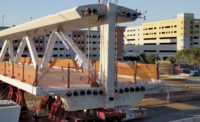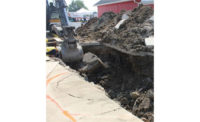W
hen Covid-19 took hold in several US states in early spring, Choate Construction responded, as many contractors did, by quickly adopting federal workplace safety guidelines for disinfecting surfaces and maintaining social distancing. Enhanced by various state lockdown measures for businesses and the general public, the new safety system seemed to work with only a handful of workers on Choate’s projects testing positive.
Then governors began slowly reopening their states, and “Memorial Day hit,” says Michael Hampton, chief administrative officer for the Atlanta-based contractor. In the weeks that followed, some positive cases occurred at Choate jobsites, most notably at a student-housing project at Appalachian State University in Boone, N.C., where roughly 30 workers had the virus, most of them in two of the four new buildings being constructed.
“We felt like the protocols that we had in place were working,” Hampton says, then craft workers dropped their guard during off-hours. Choate couldn’t tell where workers were catching the virus, and positive cases emerged at its worksites.
[For ENR’s latest coverage of the impacts of the COVID-19 pandemic, click here]
Unlike the early days of the coronavirus pandemic, which was concentrated in coastal cities such as Boston and Seattle, the current surge in cases is spread across a broad swath of the West and the South. In this phase of the outbreak, owners and contractors are commenting about jobsite concentrations of virus to local media, in essence turning their coronavirus test results into an uncomfortably transparent exercise.
With virus outbreaks flaring, the employers may also adhere to different safety practices while the lightning-rod cultural conflict over whether to require facial coverings plays out. In some markets and under some employers and owners, face coverings are required. Meanwhile, federal guidance from the Occupational Safety and Health Administration and the Centers for Disease Control and Prevention leaves it to the individual worker to decide whether to cover up.
“We felt like the protocols we had in place were working.”
– Michael Hampton, Choate Construction Co.
As a practical issue, the heat of summer has turned face coverings where they are optional into an on-and-off matter—planted firmly on the face until the worker removes it for awhile to cool off or have his or her voice more easily heard. At construction projects in a single northern New Jersey town on one steamy afternoon, workers with covered and uncovered faces labored or talked within a few feet of one another.
Birmingham-based Hoar Construction has found itself standing on both sides of the face-covering challenge. The company was building a new apartment tower, called Market 42, for a subsidiary of homebuilder Lennar, in Charlotte, N.C. In the week leading up to June 1, Hoar informed county and local officials in Charlotte that dozens of workers on the high-rise apartment building had tested positive for coronavirus. In all, there were 38 positive tests on a project staff, including subcontractors, of about 300. The contractor shut down work for several days to decontaminate the jobsite.
Before the Charlotte shutdown, Hoar said it had followed CDC and OSHA guidelines on social distancing and hygiene, including prescreening, handwashing, staggered start times for trades, increased cleanings and limited bucket hoist occupancy.
Once it learned of the positive cases in Charlotte, employees were contacted, and contact tracing started. The company made face coverings mandatory. “Considering the spike, we thought it prudent,” says Randall Curtis, Hoar’s chief operating officer. On June 24, North Carolina ordered face coverings to be worn in public and at many businesses, including construction sites.
Just as the Charlotte project shut down, Hoar informed local officials in Texas that dozens of workers had tested positive on the Texas A&M University campus in College Station. Hoar suspended work on the roughly $13-million HVAC reconstruction in a building called Dunn Hall, for a week. Of 155 workers tested on the project, 55 were positive. Testing on the job continues.
Unlike Hoar’s virus-troubled project in North Carolina, face coverings remain strongly recommended, but optional, on the Texas job. The reason: heat. With daytime temperatures in College Station exceeding 90° F and little opportunity to ventilate or cool the space during work where an HVAC duct is being replaced, Hoar is keeping use of face coverings voluntary. “Honestly,” said Curtis, “the last thing we want is to have a policy and not be able to enforce it.”
Matthew Eleazer, president of bricklayers union Local 1, based in Oregon and Washington state, says everything his 1,200 members do is heavy work, and “our guys sweat.” While some of the Local’s signatory contractors require face coverings and others don’t, the Local and the contractors have cooperated to distribute two buffs—fabric that fits around the head and neck—to each local member. The buffs are a convenient alternative to ordinary medical masks, partly because they can be pulled up or down, allowing a chance to cool off.
The Challenge of Reliable Research
Isolating the most effective virus safety measures won’t be simple. John A. Gambatese, a safety expert and professor of civil engineering at Oregon State University, anticipates difficulty in creating a control group against which a specific set of practices can be compared.
Yet there already are success stories from which to draw lessons. Les Hiscoe, CEO of Boston-based Shawmut Design and Construction, says his company “came up with plans to keep working, and we had half of our sites working throughout [the construction shutdown].”
Some of the first changes happened right at the front gates. In addition to infrared temperature screenings at site entrances and enforcing mask wearing, Shawmut internally developed a mobile, web-based portal so all workers and visitors at a site can scan a QR code with their smart device and answer basic questions about their health. “If anything comes up, the super is notified,” explains Hiscoe.
Despite working on essential jobsites through some of the Northeast’s hardest-hit areas, Shawmut has avoided any outbreaks, he says. “We had 80 active projects, and half of all of them have been ongoing through this. We haven’t had any hot spots on any projects.”









